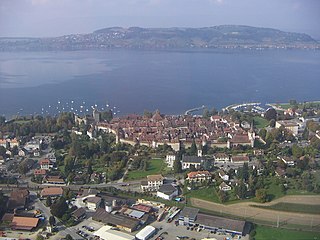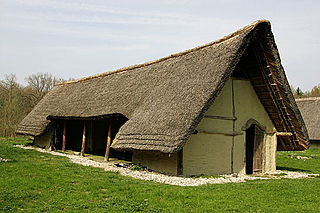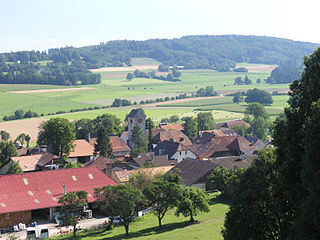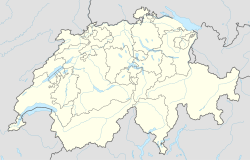
Murten or Morat is a bilingual municipality and a city in the See district of the canton of Fribourg in Switzerland.

Seedorf is a municipality in the Seeland administrative district in the canton of Bern in Switzerland.
Inkwil is a municipality in the Oberaargau administrative district in the canton of Bern in Switzerland.

Hitzkirch is a municipality in the district of Hochdorf in the canton of Lucerne in Switzerland. On 1 January 2009, Gelfingen, Hämikon, Mosen, Müswangen, Retschwil and Sulz joined Hitzkirch. On 1 January 2021, Altwis merged into Hitzkirch.
Val-de-Ruz is a municipality in the canton of Neuchâtel in Switzerland.

Hombrechtikon is a municipality in the district of Meilen in the canton of Zürich in Switzerland.

Gletterens is a municipality in the district of Broye, in the canton of Fribourg, Switzerland.

Bas-Vully is a former municipality in the district of See in the canton of Fribourg in Switzerland. On 1 January 2016 the former municipalities of Bas-Vully and Haut-Vully merged to form Mont-Vully.
Greng is a municipality in the district of See/Lac in the canton of Fribourg in Switzerland.

Haut-Vully is a former municipality in the district of See/Lac in the canton of Fribourg in Switzerland. Until 1977, it was officially known as Vully-Le-Haut. Its German name of Oberwistenlach is now little used. On 1 January 2016 the former municipalities of Bas-Vully and Haut-Vully merged to form Mont-Vully.

Noréaz is a former municipality in the district of Sarine in the canton of Fribourg in Switzerland. On 1 January 2020 the former municipalities of Corserey, Noréaz and Prez-vers-Noréaz merged to form the new municipality of Prez.
See or Lac District is one of the seven districts of the canton of Fribourg in Switzerland. Lying to the north of the canton, the district is bilingual (French/German). Its territory enclaves the two Bernese municipalities of Münchenwiler and Clavaleyres, while its own village of Wallenbuch is an exclave within Bern. It has a population of 37,695.

Vully-les-Lacs is a municipality in the district of Broye-Vully in the canton of Vaud in Switzerland.
Milvignes is a municipality in the canton of Neuchâtel in Switzerland. It was formed on January 1, 2013, by merging the former municipalities Auvernier, Bôle and Colombier.

Plateau de Diesse is a municipality in the Jura bernois administrative district in the canton of Bern in Switzerland, located in the French-speaking Bernese Jura. On 1 January 2014 the former municipalities of Diesse, Lamboing and Prêles merged into the municipality of Plateau de Diesse.

Sauge is a municipality in the Jura bernois administrative district in the canton of Bern in Switzerland. It is located in the French-speaking Bernese Jura. On 1 January 2014 the former municipalities of Plagne and Vauffelin merged into the municipality of Sauge.

Valbirse is a municipality in the Jura bernois administrative district in the canton of Bern in Switzerland. It is located in the French-speaking Bernese Jura.

Belmont-Broye is a municipality in the district of Broye, in the canton of Fribourg, Switzerland. On 1 January 2016, the former municipalities of Domdidier, Dompierre, Léchelles and Russy merged to form Belmont-Broye.

La Grande Béroche is a municipality in the canton of Neuchâtel in Switzerland. On 1 January 2018 the former municipalities of Bevaix, Fresens, Gorgier, Montalchez, Saint-Aubin-Sauges and Vaumarcus merged to form the new municipality.

Prez is a municipality in the district of Sarine in the canton of Fribourg in Switzerland. On 1 January 2020, the former municipalities of Corserey, Noréaz and Prez-vers-Noréaz merged to form the new municipality of Prez.

























